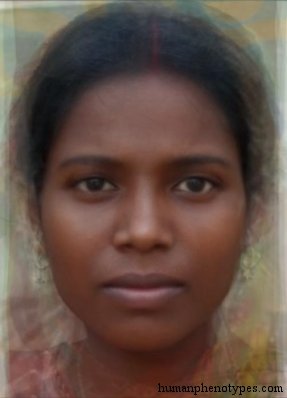Description
North Dravidian type, related to Melanids but with stronger Gondid influence. An important population element in India. Purest in Jharkhand and West Bengal, particularly in Kolarians. Typical in Santhal and Ho, extends west to Rajputana.
Transitional to Melanids in East Dekkan and East Brachids in Bengal. This type represents a significant indigenous tribal component in eastern India, particularly among Austroasiatic-speaking populations. The name derives from the Kolarian peoples who exemplify this phenotype.
Physical Traits
Skin: Black-brown, darker than most Veddoids
Hair: Curly or wavy
Height: Short
Leg length: Mesoskelic
Build: Ectomorph, sometimes endomorph
Skull: Dolicho- to mesocephalic
Cranium: Ortho- to hypsicranic
Head size: Small-headed
Nose: Meso- to platyrrhine, triangular
Face: High and angular
Lips: Relatively full
Chin: Strong
Forehead: High
Prognathism: Absent
The Kolid type displays black-brown skin that is often darker than Veddoid types (except for Malids). Hair is curly or wavy, and stature is short with mesoskelic (proportional leg length) build. Body type is predominantly ectomorphic (linear), though endomorphic variants exist.
The skull is dolicho- to mesocephalic (long- to medium-headed) and ortho- to hypsicranic (medium- to high-vaulted), with an overall small head size. The nose is meso- to platyrrhine (medium to broad) with a triangular shape. Facial features are distinctive, being high and angular with relatively full lips but strong chins and high foreheads. Notably, prognathism is absent.
Similar to Karnatids and Gondids, but distinguished from the latter by higher and longer faces, stronger chins, higher foreheads, and the absence of prognathism. These features reflect the complex admixture patterns of tribal populations in eastern India.
Literature References
The Kolid type has been extensively studied in anthropological literature:
- Eickstedt (1928, 1934, 1952c) - Named the Kolid as Indomelanid subtype
- Drexel (1955) - Used the term Kolarid
- Lundman (1967) - Classified as Indomelanid
- Knussmann (1996) - Indomelanid classification
- Sarkar (1961) - Similar to his Mundari type
- Vallois (1971) - Referred to as Melano-Indian
- Ghosa and Malik (2007) - Detailed analysis on Santhal populations






